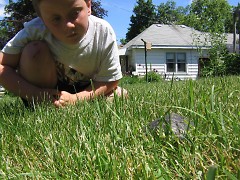Hyper-local food just got a few steps closer to home, and you don’t even need a yard.
Container gardening is an easy, low-maintenance project that will reward you with year-round edibles. The benefits of growing food in your living space go far beyond lowering the grocery bill. Plants beautify your home, clean your air and educate your family about the nature and provenance of what they eat.
If you live in an apartment, you do not have to pine for the days when you will have a yard to grow some food. Potted plants can thrive, continually, on any ledge or table that receives a lot of direct sunlight. With the proper set-up, it only takes a few minutes a day to ensure your plants produce all year. All you need is a window and you can start a garden of healthy, organic food today.
Herbs
Herbs are a great starting point for the budding windowsill farmer. Small pots of herbs can be found at most garden centers in the spring and summer. Basil and rosemary are especially suited for indoor gardening. If live plants are not in season, you can look for packaged seeds in a store or catalog. Just be sure to follow the directions on the package and store the extra seeds in a cool, dry place (like an air-tight container in the refrigerator or basement).
Herbs are a great starting point for the budding windowsill farmer. Small pots of herbs can be found at most garden centers in the spring and summer. Basil and rosemary are especially suited for indoor gardening. If live plants are not in season, you can look for packaged seeds in a store or catalog. Just be sure to follow the directions on the package and store the extra seeds in a cool, dry place (like an air-tight container in the refrigerator or basement).
A small, 3-4 inch, pot usually provides enough root space for these small plants. Terra cotta pots, although more expensive than their plastic counterparts, will make growing much easier. The dried-clay that forms the pot will store and release moisture for the plant, which allows you to wait longer between watering.
Fruits and Vegetables
If you have a bit of experience growing plants, you may be ready to try your hand at indoor fruits and vegetables. These plants require more care and maintenance so expect to spend up to five minutes a day on a few plants.
If you have a bit of experience growing plants, you may be ready to try your hand at indoor fruits and vegetables. These plants require more care and maintenance so expect to spend up to five minutes a day on a few plants.
Choose a container suitable for the adult size of the plant. Perennials, in general, will require more root space because they remain alive even when not producing fruit. A ratio of adult height to pot diameter of 2:1 is usually adequate. Alternatives to planters, like hydroponics or the upside-down tomato planter, lend themselves well to indoor gardening. (Although, if you use the latter, make sure there is something below the plant to catch any falling water.)
Try to match your choice of plants to the amount of space you have. Big windows with room for a trellis call for big plants like tomato, cucumber and squash. Small sills are great for peppers and root vegetables like carrots, onions and garlic. Whichever plants and methods you choose, be sure to research and provide the care required for each species of plant. The Heartside Gardeners, a community of gardeners on Facebook, would be a great place to look for help on choosing species and methods suitable for your climate and space.
Maintenance
In order to maintain a hearty, vibrant crop of your favorite food, there are a few things you should remember. Plants need water, food and space to grow. Any cup, container or watering can will work to get water from the sink to the plant. Add your water slowly and stop as soon as it trickles from the bottom of the pot. Food is simple too, just purchase a fertilizer that is made for edible plants and follow the directions on the container.
In order to maintain a hearty, vibrant crop of your favorite food, there are a few things you should remember. Plants need water, food and space to grow. Any cup, container or watering can will work to get water from the sink to the plant. Add your water slowly and stop as soon as it trickles from the bottom of the pot. Food is simple too, just purchase a fertilizer that is made for edible plants and follow the directions on the container.
When it comes time to adjust the space that your plant needs, you can prune, re-pot or re-start. Prune perennials with hearty stalks or branches like small fruit trees. Re-pot any perennials that are over a year old. Carefully remove the plant from the pot and shake or brush off any excess dirt. Layer the roots into a new pot with fresh potting soil. Some plants will require you to re-start. These plants, called annuals (and usually vegetables), will not produce more than once so you will need to start over with a new batch of seeds.
In just a few weeks, you can start reaping the rewards of free, locally grown food. Any food you are unable to eat yourself: share with friends, can for later or just donate to a local food kitchen.
If you would still like some more help and information, the Grand Rapids Public Library is hosting a container gardening event on April 21 and 24. Simply go to www.grpl.org, click on events and search for container gardening.
The Rapidian, a program of the 501(c)3 nonprofit Community Media Center, relies on the community’s support to help cover the cost of training reporters and publishing content.
We need your help.
If each of our readers and content creators who values this community platform help support its creation and maintenance, The Rapidian can continue to educate and facilitate a conversation around issues for years to come.
Please support The Rapidian and make a contribution today.


Comments
Matthew,
thanks for writing about this. I know little about gardening but feel like your piece helped bring a few things to light for me.
this is how i plan on filling up space in my yard. a neighborhood potted garden would be lots of fun